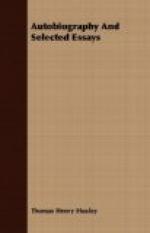As I grew older, my great desire was to be a mechanical engineer, but the fates were against this and, while very young, I commenced the study of medicine under a medical brother-in-law. But, though the Institute of Mechanical Engineers would certainly not own me, I am not sure that I have not all along been a sort of mechanical engineer in partibus infidelium.[6] I am now occasionally horrified to think how very little I ever knew or cared about medicine as the art of healing. The only part of my professional course which really and deeply interested me was physiology, which is the mechanical engineering of living machines; and, notwithstanding that natural science has been my proper business, I am afraid there is very little of the genuine naturalist in me. I never collected anything, and species work was always a burden to me; what I cared for was the architectural and engineering part of the business, the working out of the wonderful unity of plan in the thousands and thousands of diverse living constructions, and the modifications of similar apparatuses to serve diverse ends. The extraordinary attraction I felt towards the study of the intricacies of living structure nearly proved fatal to me at the outset. I was a mere boy—I think between thirteen and fourteen years of age—when I was taken by some older student friends of mine to the first post-mortem examination I ever attended. All my life I have been most unfortunately sensitive to the disagreeables which attend anatomical pursuits, but on this occasion my curiosity overpowered all other feelings, and I spent two or three hours in gratifying it. I did not cut myself, and none of the ordinary symptoms of dissection-poison supervened, but poisoned I was somehow, and I remember sinking into a strange state of apathy. By way of a last chance, I was sent to the care of some good, kind people, friends of my father’s, who lived in a farmhouse in the heart of Warwickshire. I remember staggering from my bed to the window on the bright spring morning after my arrival, and throwing open the casement. Life seemed to come back on the wings of the breeze, and to this day the faint odor of wood-smoke, like that which floated across the farm-yard in the early morning, is as good to me as the “sweet south upon a bed of violets."[7] I soon recovered, but for years I suffered from occasional paroxysms of internal pain, and from that time my constant friend, hypochondriacal dyspepsia, commenced his half century of co-tenancy of my fleshly tabernacle.




